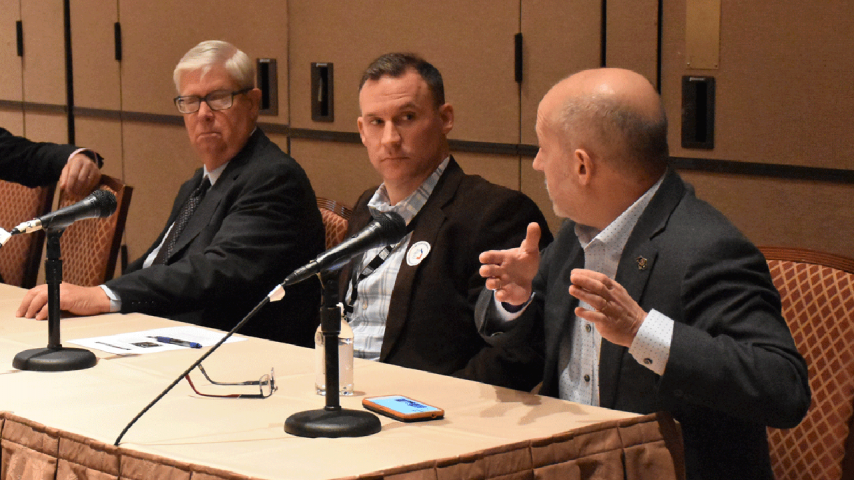
The International Code Council recently held its 2019 annual conference in Las Vegas.
As part of ICC’s government relations forum during a panel called Up-to-Date Building Codes Provide Significant Mitigation Savings, I discussed aspects of the Multihazard Mitigation Council’s study Natural Hazard Mitigation Saves. The panel also included Jeff Czajkowski, of the National Association of Insurance Commissioners, and Kevin Simmons, of Austin College, who spoke about related topics.
The 2019 edition of Natural Hazard Mitigation Saves updates the 2005 benefit-cost analysis of the same name, but addresses a much broader suite of mitigation measures: adopting up-to-date codes, exceeding codes, private-sector building retrofit, retrofitting transportation and utility infrastructure, and public-sector retrofit. The study addressed aspects of up-to-date codes having to do with greater flood freeboard relative to 1990-era codes, increases in seismic strength and stiffness, defensible space and fire-resistive materials, and various strength and detailing requirements for wind.
The panel agreed that up-to-date codes are affordable. For example, new buildings are 50% stronger and stiffer in resisting seismic forces than a generation ago for only about 1% greater construction cost, and for an even smaller percentage of first price. The reason is that the structural materials associated with lateral strength account for only about 2% of the construction cost of a new building, which itself in some cases only represents one-third of first price including land.
The public prefers and is willing to pay for resilient buildings: I cited a scholarly public-opinion survey performed for the USGS’s HayWired scenario. Simmons cited the example of Moore, Oklahoma’s enhanced wind provisions and the fact that the enhanced provisions had no effect on Moore’s housing market.
One can dispense with the objection that private-sector owners commonly decline to exceed code in new buildings by recognizing that building owners have supported mandatory, across-the-board code enhancements that keep the playing field level, whereas voluntary enhancement disadvantages the owner who opts for it relative to neighbors who do not.
Natural Hazard Mitigation Saves includes a wide variety of benefit categories in the numerator of the benefit-cost ratio: reductions in property damage, business interruption, additional living expenses, deaths, injuries, post-traumatic stress disorder, the overhead and profit portions of insurance premiums, and some environmental benefits. The study also quantified new jobs and savings to the federal treasury, although to avoid double-counting, these benefits are not included in the numerator of the benefit-cost ratio.
I acknowledged the unfulfilled desire to include other intangibles: pets, peace of mind, memorabilia, culture, and protection of disadvantaged populations.
CFIRE member Tim Ryan pointed out, to general agreement, that code enhancements are fairly useless without the political will to enforce codes, which he argued shows no sign of growth.
One way to measure the value of a building under varying levels of resilience is to estimate the cost of ownership: the first cost, which increases with design requirements such as seismic strength, plus future repair costs, which generally decrease with increasing design requirements. The sum is the total cost of ownership. If one plots the first cost, future loss, and total cost of ownership as curves on an x-y chart where x measures strength (or other measure of design requirements), the total cost of ownership tends to have a U shape, with a lowest y-value (called a local minimum) indicating what one can call an optimal design level.
Natural Hazard Mitigation Saves shows that in many places, for many perils, current code is not at that optimal point, but rather produces a false economy in terms of lower first cost but higher total cost of ownership.
The report shows that the last 30 years of code development costs America about $1 billion per year in higher first cost, but saves society $13 billion in the long run for every year of new construction. But an optimal, future code could save America an additional $16 billion for every year of new construction, for an added first cost of $4 billion.
The panel generally agreed that society benefits when it adopts and enforces up-to-date codes, and that engineers, economists, building officials, code writers, insurance commissioners, and other building professionals all have an interest and a role to play in promoting up-to-date codes and future code enhancements.
The National Institute of Building Sciences soon will release the 2019 edition of Natural Hazard Mitigation Saves. NIBS and MMC hope to continue to expand the study. For example, we would like to address the benefits and costs of business continuity planning and disaster recovery (BCP/DR), direct action by government entities such as hurricane warnings and flood-control measures, and restoring disaster-damaged buildings and lifelines to a higher performance level than they had before the disaster (called building back better). We also hope to use the study to inform the construction of new financial mechanisms that incentivize owners to do mitigation by having lenders, insurers, and governments share some of the co-benefits of mitigation back to the owner, potentially reducing the owner’s total cost of ownership below that of less-resilient design.




